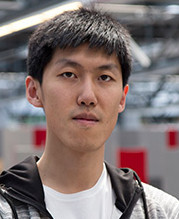News Archive
25.11.2016
Talk @ NIP by Fan Zhang on Thursday, December 15th, 2016, 16:00 hrs
Title: "Visual perception of canonical material modes and its interactions with canonical lighting modes"
Notes:
Fan Zhang is at the <link http: www.io.tudelft.nl en organisation personal-profiles phd-candidates zhang-f external-link-new-window external link in new>University of Delft, in Sylvia Pont's lab.
Introduction
Most studies in the area of visual perception of opaque materials concern the matte (diffuse scattering) and glossy (forward scattering) material modes.. In order to account for a wider range of materials, we included velvety (asperity scattering) and glittery (meso-facet scattering) material modes in a basis set, represented by photographs of the same bird-shaped 3D objects.
With the four canonical material modes, optical mixing (Griffin, 1999) was implemented in developing a novel material probe, MatMix 1.0. This probe allows quantitative measurement of visually perceived qualities of materials. To further study the material and lighting confounds, the probe was then adjusted to MixIM 1.0 which allows optical mixing of both material modes and lighting modes.
Methods
To test the probe, matching experiments were conducted in which inexperienced observers were instructed to adjust the probe to match the material or lighting of a test stimulus. In material matching experiments observers were well able to handle the probe and match perceived materials. Results were robust across individuals, across combinations of materials, and across lighting conditions. In lighting matching experiments most observers performed above chance level, though individual differences were found, especially when the velvety mode was presented.
To explicitly test the material and lighting dependent perceptual interactions found in the matching experiments, we designed a 4AFC task. In each trial, observers were shown a pair of images and four options: “same materials same lightings”, “same materials different lightings”, “different materials same lightings” and “different materials different lightings”. Results showed that saying whether the illuminations are different or not when the materials are different is harder than when the materials are the same. However, when the lightings are different, it is almost as easy to say whether the materials are different or not as when the lightings are the same.
Conclusion
We developed a novel material probe to quantitatively test material perception of inexperienced observers in a wider range of opaque materials than just matte-glossy variations. We argue that the “optical mixing” approach is intuitive as it combines key image characteristics in a painterly approach.
We further developed the probe to explicitly test material-lighting confounds, and found individual differences in both matching experiments and discrimination experiments.
Acknowledgement
This work has been funded by the EU FP7 Marie Curie ITN project PRISM (PITN-GA-2012-316746).

